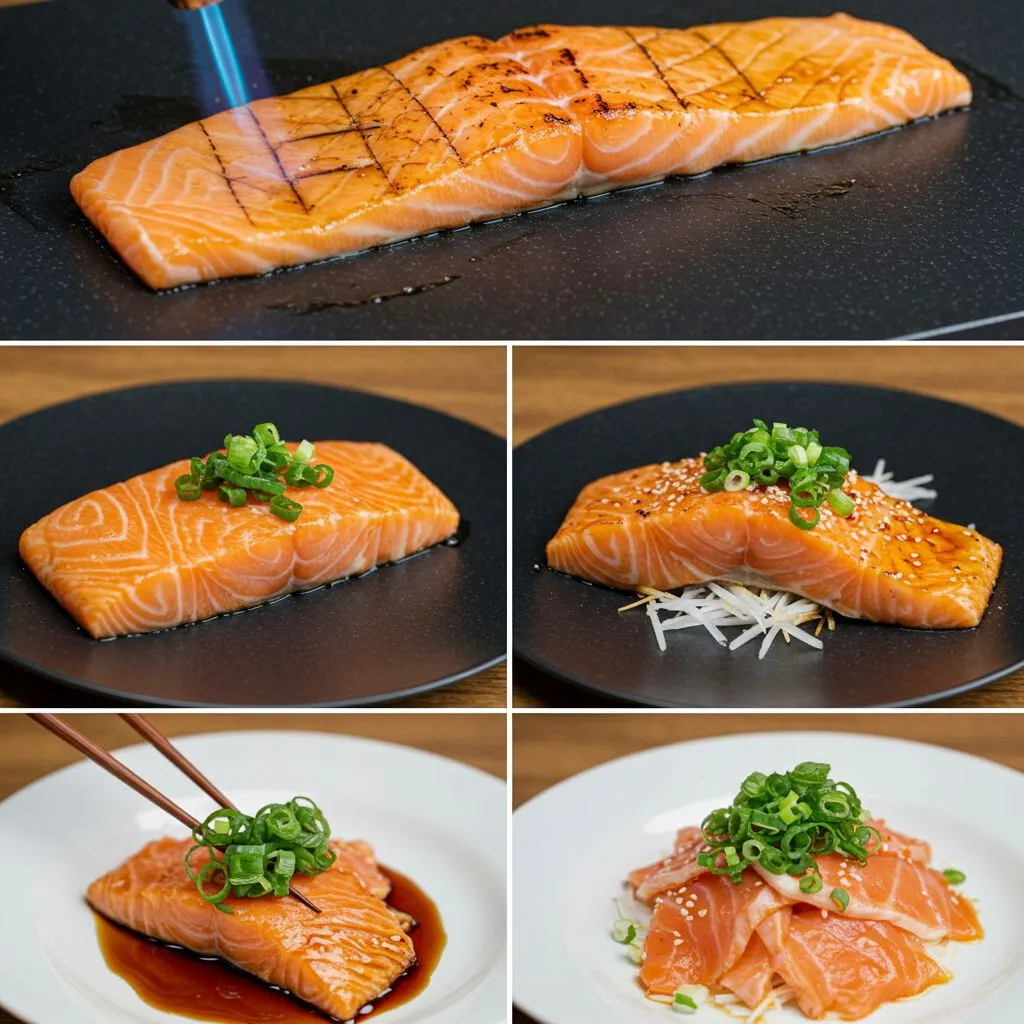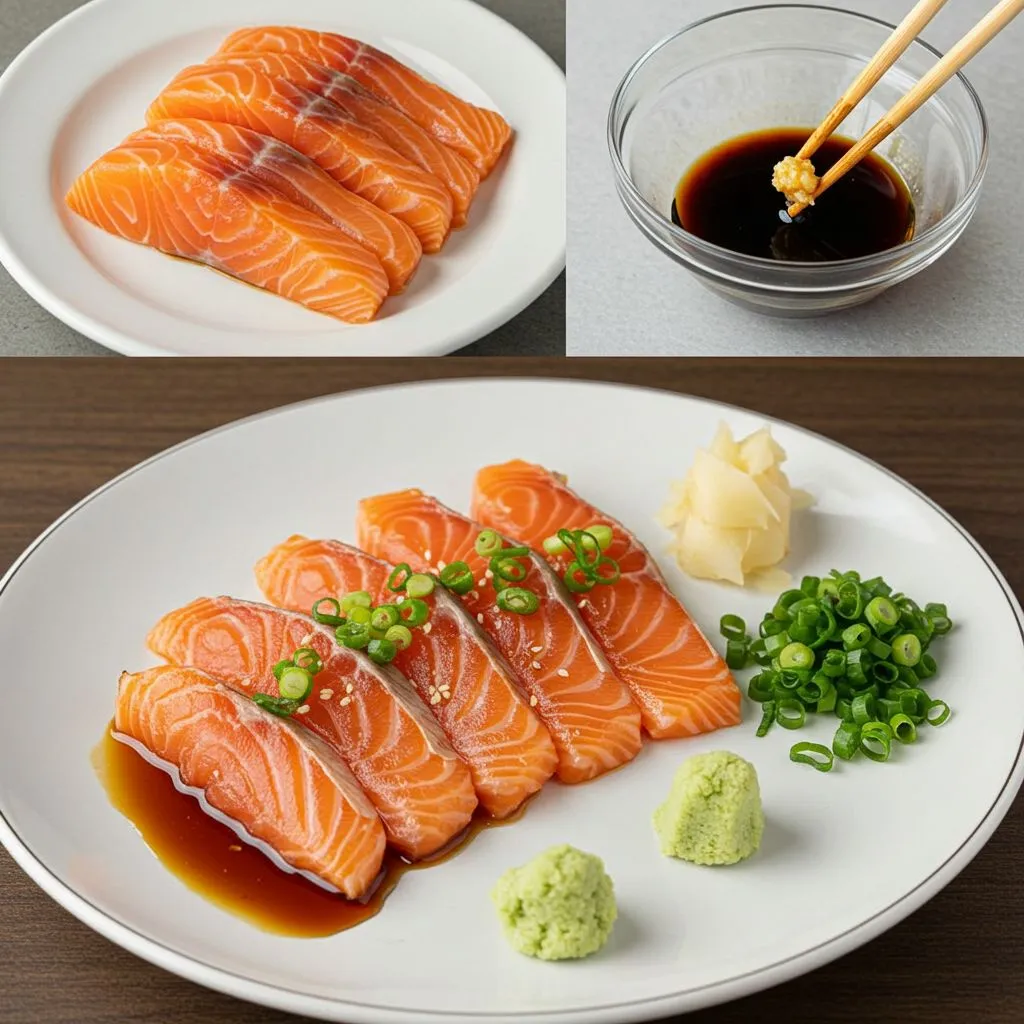Salmon tataki with ponzu sauce is an exquisite Japanese appetizer that combines the fresh, delicate flavors of sushi-grade salmon with a tangy, savory dipping sauce. This dish, characterized by its quick sear and thinly sliced presentation, is perfect for impressing guests or treating yourself to an elegant meal at home. In this guide, we will explore the preparation of salmon tataki, the nuances of making ponzu sauce, and tips for serving this delightful appetizer.
What is Salmon Tataki?
Salmon tataki is a Japanese culinary dish that features salmon that has been briefly seared to achieve a distinctive texture while keeping the center raw. The term ‘tataki’ refers to the technique of lightly searing the fish, which enhances the flavors without cooking it entirely. This method ensures that the salmon remains tender and succulent, offering an exquisite blend of textures and tastes that seafood lovers crave. Typically served with a ponzu dipping sauce, salmon tataki is a popular choice in sushi restaurants and homes alike, celebrated for its fresh taste and elegant presentation.
How is Salmon Tataki prepared?
To prepare salmon tataki, you first need to select high-quality sushi-grade salmon, which is crucial for both safety and flavor. The salmon filet is then quickly seared in a cast iron skillet over high heat for just a few seconds per side, allowing the outside to develop a light crust while keeping the inside raw. After searing, the salmon is set aside to cool slightly before being thinly sliced. The resulting thin slices of seared salmon are then arranged beautifully on a plate, ready to be paired with ponzu sauce. This simple yet effective preparation method ensures that every bite is bursting with umami flavor and freshness.
What are the key ingredients in Salmon Tataki?
The key ingredients in salmon tataki are straightforward yet essential to achieving the perfect dish. First and foremost, you need sushi-grade salmon to ensure the highest quality and safety. Alongside the salmon, ponzu sauce is vital, providing a balanced flavor profile with its combination of soy sauce, lemon juice, mirin, and sometimes rice vinegar. To enhance the presentation and taste, a sprinkle of sesame seeds and finely sliced green onion or scallion is often added. These ingredients not only complement the salmon but also create a visually appealing dish that is just as pleasing to the eye as it is to the palate.
Why is Sushi Grade Salmon important?
Choosing sushi-grade salmon is essential when making salmon tataki, as it ensures the fish is safe for raw consumption. Sushi-grade salmon is specially handled and stored to minimize the risk of parasites and bacteria, which can be harmful if ingested. This grade of salmon is typically sourced from suppliers who adhere to stringent quality standards, ensuring that the fish is fresh and of the highest quality. Additionally, sushi-grade salmon tends to have a better flavor and texture, making it ideal for dishes like tataki where the fish is the star of the meal. Selecting the right type of salmon ensures that your dish is not only safe but also delicious.

Table of Contents
How to make Ponzu Sauce for Salmon Tataki
Making ponzu sauce for salmon tataki is a straightforward process that results in a flavorful dipping sauce that enhances the dish. Ponzu sauce is a zesty, citrus-infused condiment that blends the savory flavor of soy sauce with the vibrant freshness of citrus fruits such as lemon or lime. It often contains mirin, a sweet rice wine, and occasionally rice vinegar to enhance its depth. This harmonious blend of flavors complements the rich taste of the salmon, adding a refreshing element that elevates the overall dining experience. Preparing ponzu sauce at home allows you to customize the balance of flavors to suit your taste buds, turning it into a versatile pairing for a wide range of dishes.
What ingredients are needed for Ponzu Sauce?
To create a delicious ponzu sauce, you will need a few key ingredients. Japanese soy sauce usually forms the foundation of the sauce, providing it with a rich, savory flavor. Fresh lemon juice or lime juice adds a citrusy brightness, while mirin contributes a subtle sweetness that offsets the saltiness of the soy sauce. Some recipes also call for rice vinegar to enhance the tangy profile of the sauce. Optionally, you can include dashi, a Japanese soup stock, to add depth and umami flavors. Together, these ingredients create a versatile ponzu sauce that can elevate not only salmon tataki but also a variety of seafood and vegetable dishes.
How do you balance flavors in Ponzu Sauce?
Balancing flavors in ponzu sauce is essential to achieving a well-rounded condiment that compliments salmon tataki beautifully. Start with the soy sauce as the base, which provides saltiness and umami. Then, gradually add lemon or lime juice to introduce acidity, which brightens the overall flavor. Mirin should be added next to introduce sweetness, creating a harmonious contrast to the saltiness. Taste the sauce frequently as you mix the ingredients, adjusting the acidity, sweetness, and saltiness until you find the right balance. Remember, the goal is to create a sauce that enhances the flavors of the salmon without overpowering them, allowing for a perfect pairing that highlights the dish’s freshness.
What type of Salmon is best for Tataki Salmon?
When it comes to choosing the best type of salmon for tataki, sushi-grade salmon is the only choice for safety and flavor. The most commonly used types include Atlantic salmon and Pacific salmon, both of which offer rich flavors and a buttery texture. Atlantic salmon, prized for its richer fat content, offers a luxurious texture, whereas Pacific salmon varieties like sockeye or king salmon are praised for their robust flavor and vibrant color. Each type of salmon has its own distinct characteristics, so selecting one based on personal preference can enhance your tataki experience. Regardless of the variety, ensure that the salmon is fresh and high-quality for the best results.
What is the difference between Salmon Filet and other types?
Salmon filet is a specific cut of salmon that is favored for its tender texture and ease of preparation. The filet, unlike whole salmon or steak cuts, is sliced from the side of the fish, allowing for thin, delicate slices that are ideal for dishes like salmon tataki. The filet has less bone and skin, making it easier to work with and ensuring a cleaner presentation when served. Other types of salmon cuts, such as steaks, can be thicker and may not provide the same melt-in-your-mouth experience that a thinly sliced filet offers. Selecting a premium-quality filet is crucial for tataki to attain the ideal texture and flavor.
How do you choose Sashimi-Grade Salmon?
Choosing sashimi-grade salmon requires careful consideration to ensure safety and quality. Start by sourcing your salmon from reputable fishmongers or sushi restaurants that specialize in high-quality seafood. Look for salmon that is visibly fresh, with bright, clear eyes, firm flesh, and a vibrant color. Its aroma should be light and reminiscent of the ocean, not strongly fishy.It’s also important to check that the fish has been handled properly, ideally kept on ice and stored at the right temperatures. If available, inquire if the salmon is certified sashimi-grade, as this designation indicates it has met strict safety standards for raw consumption. Ensuring you select high-quality sashimi-grade salmon will guarantee a delicious and safe dining experience.

How to serve Salmon Tataki as an Appetizer
Serving salmon tataki as an appetizer is all about presentation and pairing it with complementary flavors. To create an inviting dish, arrange the thinly sliced seared salmon on a shallow bowl or plate, showcasing the pink center and golden edges. Drizzling ponzu sauce over the salmon enhances its visual appeal while allowing guests to dip the slices as they desire. For a refreshing accompaniment, consider a salmon tataki salad made with mixed greens, shredded carrots, and a sprinkle of sesame seeds. This vibrant presentation not only looks appetizing but also provides a delightful contrast of textures and flavors that will entice your guests.
What are the best pairings for Salmon Tataki Salad?
When serving a salmon tataki salad, it’s essential to consider flavor pairings that enhance the dish without overshadowing the delicate taste of the salmon. Fresh greens, such as arugula or baby spinach, provide a crisp base that complements the rich flavors of the seared salmon. Adding thinly sliced vegetables, like cucumbers and radishes, can introduce additional crunch and freshness. A light dressing featuring ponzu sauce, sesame oil, and a dash of rice vinegar can tie the elements together, creating a harmonious blend of flavors. Additionally, garnishing with toasted sesame seeds and finely chopped scallions adds visual appeal and a nutty flavor, making the salad a delightful accompaniment to the salmon tataki.
How to plate Salmon Tataki for presentation?
Plating salmon tataki for presentation is an art that can elevate the dining experience. Start by arranging the thinly sliced seared salmon artfully on a shallow bowl or plate, overlapping the slices slightly to create a beautiful fan shape. Drizzling ponzu sauce around the salmon rather than directly on top allows the vibrant colors to shine through. Consider adding a touch of color with finely chopped green onions or shiso leaves, which not only enhances the visual appeal but also adds a layer of fresh flavor.To add a final touch, scatter sesame seeds on top to give the dish a refined appearance. A well-plated salmon tataki will entice diners and set the stage for an enjoyable culinary experience.
What are some variations of Salmon Tataki?
There are numerous exciting variations of salmon tataki that can cater to different tastes and preferences. One popular alternative is tuna tataki, which follows a similar preparation method but uses fresh tuna instead of salmon. The meaty texture and mild flavor of tuna create a different yet equally delightful experience. Additionally, you can experiment with different marinades or dipping sauces, such as a spicy ponzu or a ginger-infused soy sauce, to add unique flavor profiles. For a more adventurous twist, consider incorporating fruits like mango or avocado into the dish, providing a fresh contrast to the savory elements. These variations can keep the dish exciting and cater to diverse palates.
Can you use other types of fish like Tuna?
Yes, you can definitely use other types of fish like tuna to create a delicious tataki dish. Tuna tataki follows a similar preparation method to salmon tataki, where the fish is briefly seared to maintain its raw center. The rich flavor and firm texture of tuna make it an excellent alternative, and it pairs beautifully with ponzu sauce. Other fish options include yellowtail or even mackerel, each offering unique flavors and textures. The versatility of the tataki method allows for experimentation, enabling you to create various dishes that showcase the freshness and excellence of various types of seafood. Ultimately, the choice of fish can enhance the tataki experience, making it a delightful addition to your culinary repertoire.
What creative twists can you add to Salmon Tataki?
Adding creative twists to salmon tataki can elevate the dish and make it even more enjoyable. ingredients is one effective way to infuse new flavors. soy sauce, mirin, and citrus zest before searing, enhancing the umami profile. Experimenting with toppings like avocado slices or microgreens can also enhance the dish’s richness and freshness. Incorporating a spicy mayo or wasabi-infused sauce as an alternative dipping option can provide a delightful kick. For a touch of crunch, consider adding fried shallots or crispy garlic on top, offering a delightful contrast to the tender salmon. These creative twists not only enhance the flavor but also make the dish visually stunning.

Tips for perfecting your Salmon Tataki
Perfecting your salmon tataki involves mastering several key techniques to ensure the best results. One crucial tip is to sear the salmon for just the right amount of time—typically only a few seconds per side—so that the outside is cooked while the inside remains raw. Using a hot cast iron skillet helps to achieve an even sear, locking in moisture and flavor. Additionally, slicing the salmon thinly is essential for a delicate texture. A sharp knife and a steady hand will ensure you create perfect, even slices. Lastly, avoid common mistakes, such as overcooking the salmon or not using high-quality fish, which can compromise the dish’s integrity. By following these tips, you can create delicious salmon tataki that impresses every time.
How long should you sear the salmon?
The key to achieving perfectly seared salmon tataki is knowing precisely how long to sear the fish. Ideally, you should sear the salmon for about 10 to 15 seconds per side, depending on the thickness of the filet. The goal is to create a light crust on the outside while keeping the inside raw and tender. Using high heat in a cast iron skillet helps to achieve this rapid sear, ensuring that the fish remains moist and flavorful. It’s essential to monitor the salmon closely during the searing process to avoid overcooking, as this can detract from the dish’s signature texture and flavor. With practice, you’ll master the timing for a perfect sear that highlights the freshness of the salmon.
What techniques ensure thin slices of salmon?
To achieve thinly sliced salmon for tataki, employing the right techniques is vital. Begin with a sharp knife, since a dull one might shred the fish instead of create clean cuts. It’s also beneficial to chill the salmon in the refrigerator for about 30 minutes before slicing; this firms up the flesh, making it easier to cut. When slicing, aim to cut against the grain of the fish, which will result in more tender slices. Use a gentle sawing motion rather than pressing down hard, allowing the knife to glide through the salmon. Mastering these techniques will ensure that your salmon tataki has the ideal thin slices that are both visually appealing and delicious.
What are common mistakes to avoid when making Tataki Salmon?
When making salmon tataki, there are several common mistakes to avoid to ensure a successful dish. One of the most significant errors is using low-quality salmon; always opt for sushi-grade salmon to guarantee safety and flavor. Another mistake is overcooking the fish; searing should be minimal to retain the raw center. Moreover, skipping the resting period after searing the salmon can cause it to lose moisture, impacting the texture. Failing to slice against the grain can also lead to tougher pieces. By focusing on these details, you can craft a tasty and visually striking salmon tataki that highlights the finest attributes of both the fish and the dish.
FAQs About Salmon Tataki with Ponzu Sauce
1. What is salmon tataki?
Salmon tataki is a Japanese dish where sushi-grade salmon is lightly seared on the outside while keeping the inside raw, creating a tender texture and fresh flavor.
2. Why is sushi-grade salmon important for tataki?
Using sushi-grade salmon makes sure the fish is safe to eat raw and delivers the finest flavor and texture for the dish.
3. How do you prepare salmon tataki?
The salmon is quickly seared over high heat for a few seconds on each side, cooled slightly, then thinly sliced and served with ponzu sauce.
4. What is ponzu sauce made of?
Ponzu sauce is a citrus-based condiment typically made with soy sauce, lemon or lime juice, mirin (sweet rice wine), and sometimes rice vinegar for extra depth.
5. How do you balance the flavors in ponzu sauce?
Balancing soy sauce for saltiness, citrus juice for acidity, and mirin for sweetness creates a harmonious and refreshing dipping sauce.
6. What is the best salmon to use for tataki?
High-quality sushi-grade salmon like Atlantic salmon (for a richer texture) or Pacific salmon (for a bold flavor) are ideal choices.
7. How thin should the salmon be sliced for tataki?
The salmon should be sliced very thinly against the grain, using a sharp knife, to ensure a delicate texture and beautiful presentation.
8. Can other fish be used instead of salmon?
Yes, tuna is a popular alternative for tataki, but yellowtail or mackerel can also be used for a different flavor experience.
9. What are common mistakes to avoid when making salmon tataki?
Steer clear of using poor-quality fish, over-searing the salmon, neglecting to let it rest after searing, and cutting the fish improperly.
10. How can you creatively enhance salmon tataki?
You can marinate the salmon before searing, add toppings like avocado or microgreens, or serve it with spicy mayo or crispy garlic for extra flavor.

